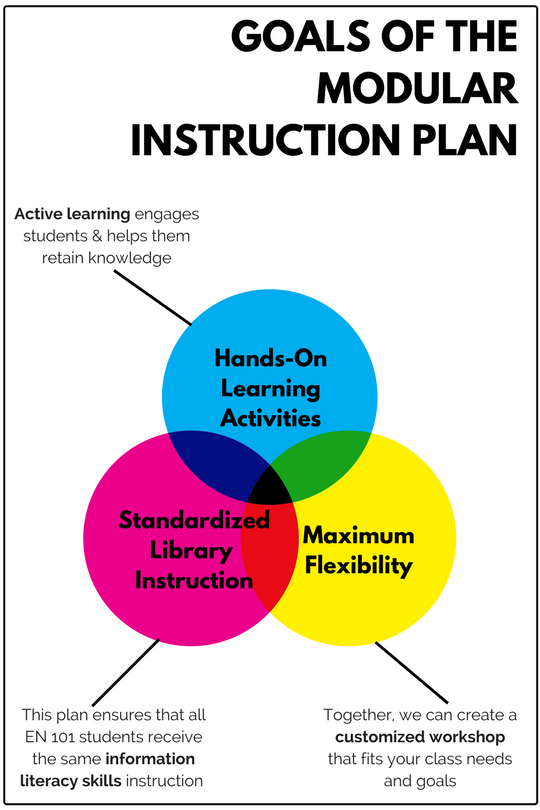
Modular IL Instruction

The demand for our library-led information literacy instruction sessions spiked 74% between 2014 and 2017 (and requests for EN 101-specific library instruction rose a total of 78% for us in just one academic year). After crunching these numbers, I knew that we needed to modify our instructional model to not only accommodate the sharp rise in demand for library instruction, but also to refine the goals of our instruction program as a whole and enhance the overall quality of instruction that we were providing.
After quite a bit of research and brainstorming, I came up with a proposal to create a modular information literacy instruction (MILI, for short) program. I created a core “menu” of modules (shown below) that each included different lesson plans to reinforce specific skills and concepts for that module. Active learning was a major part of my instructional design, and each lesson plan incorporates a hands-on activity.
Considerations
Time
Our library has five librarians that share a wide range of roles - reference shifts, troubleshooting e-resource and tech issues, collection development, and instruction - in addition to each of our main job duties (Digital Services, Public Services, or Instructional Services). Library instruction is often a very challenging and time-intensive responsibility, and one of my main priorities for the MILI program’s design was to ensure that my colleagues would not be unnecessarily weighed down with instructional content creation. I intentionally designed each module and activity to be picked up and used as-is. I also included instructions and checklists for each activity so that my colleagues wouldn’t feel overwhelmed by the new process.
Workload
In the lead-up to the MILI program’s design, we had relied on a subject liaison model to assign librarians to instruction sessions. For instance, if an EN 101 session was requested, our English and Communications subject liaison took on the class. Now, in an effort to make my colleagues’ instructional workloads more equitable, I assign librarians to teach each class based on his or her workload and his or her availability at the time of the session.
Consistency of Instructional content
It was important to me that our information literacy instruction was consistent in terms of content and skill-acquisition among our first-year students, especially. Implementing the MILI program allowed me to ensure that each EN 101 and 102 class was receiving the same basic information literacy instruction so that we could more effectively build on those skills in their sophomore, junior, and senior academic years.
Versatility & Flexibility
Most librarians are familiar with requests that we get from faculty members to “do it all” in one 50- or 75-minute session. Research has shown that students don’t learn as well when they are overwhelmed with a multitude of information; however, they are generally more successful when an instructional session focuses on one or two learning outcomes. I placed time estimates on each of the modules so that faculty would have to thoughtfully select which skills and concepts would be most beneficial for their students in a single class meeting. This allows faculty to customize the instruction session that they want - and keeps students from zoning out during long, non-engaging rundowns of library services!

I designed this graphic for the MILI LibGuide in order to quickly communicate the benefits of our new program to faculty members.
You can view each MILI module, activity, and all corresponding instructional materials here.
Presentation Examples
Assessment
From August 2017 through April 2019, our teaching librarians collected a total of 850 student worksheets that we evaluated for students’ proficiency at each module and activity’s stated learning outcomes. After doing a literature review to identify best practices for constructing instructional rubrics, I scored each worksheet and compiled the results into spreadsheets for easy data evaluation. You can see the rubrics and performance overviews for each activity in the report I created entitled “Assessing the Modular Information Literacy Instruction (MILI) Content: A Two-Year Retrospective Review.”
Below, I have included the data charts for the “Narrowing a Topic” activity in Module #1 - Developing a Search Strategy so that you can get an idea of how the assessment data has been displayed in the report linked above.









